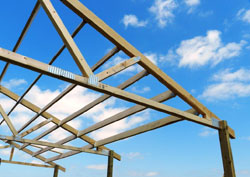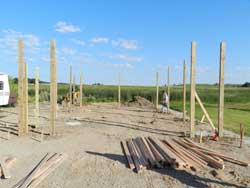Sure – offering the best possible value for your building dollar is always the mission of Hansen Buildings, but just superior quality isn’t our only goal. As good stewards of our planet’s resources, environmentally sound design is just as important to us. The best and most efficient materials are chosen for every Hansen Pole Building, and being green is being best. Our promise is to minimize the environmental impact of your new building.
 Hansen Buildings’ history is one of integrating “green” and environmental friendly principles into our general building practices. Even before being “green” was fashionable, we utilized sustainable design through the use of regionally produced, rapidly renewable and recyclable material sources. Our typical open floor plans promote the use of polycarbonate light panels and windows, which maximize the use of natural lighting and reduce the use of electric lighting.
Hansen Buildings’ history is one of integrating “green” and environmental friendly principles into our general building practices. Even before being “green” was fashionable, we utilized sustainable design through the use of regionally produced, rapidly renewable and recyclable material sources. Our typical open floor plans promote the use of polycarbonate light panels and windows, which maximize the use of natural lighting and reduce the use of electric lighting.
The Hansen Pole Buildings design is based upon engineering for optimal materials use. By avoiding waste from structural over design a minimum of materials can be utilized to achieve a maximum enclosed space. We believe less is more. Our designs use smaller net volumes of larger, high strength materials, rather than massive quantities of smaller pieces. This allows fewer pieces required to resist snow, wind and seismic forces and less labor and fuel is required for erection.
All materials are ordered and manufactured to the exact sizes of the building blueprints and plans, allowing for very little excess. Waste is further reduced because many of the components are pre-cut and sized for the job. For instance, steel panels are ordered in the exact sizes needed – to the one-half inch! Trusses and glu-laminated columns are factory manufactured under controlled conditions, in order to reduce on-site cutting waste. All packaging, metal and wood scraps can be easily recycled at local facilities. Efficient material design and usage is eco-friendly and makes your new building more affordable.
Life cycle cost is a method to determine the entire cost over a product’s intended life span. For buildings, the main factors considered are initial, operating, replacement and maintenance or repair costs. Hansen Buildings’ post-frame construction methods contain many green building construction elements which support minimized life cycle costs. These include reduced site disturbance, less use of wood to create the structural system, engineered roof structure systems, wall and ceiling cavities with space to accommodate International Energy Conservation Code insulation requirements, and interior design flexibility due to the absence of interior structural columns. The process of manufacturing products is energy intensive. By using longer lasting, more durable, lower maintenance components energy is saved and solid waste issues are reduced.
Building site soil disturbance and erosion is reduced as the Hansen post-frame system utilizes fewer, widely spaced footings. Digging fewer holes also lowers the volume of concrete required and speeds construction time, both of which reduce foundation costs.
 Since our very first building, we’ve been using post frames manufactured from renewable wood sources, such as Southern Pine, Douglas Fir and Spruce-Pine-Fir. As lumber is the “guts” of pole barn design, ours is provided only from suppliers who encourage responsible forest management. Lumber used in your new Hansen Building is certified, in part, to various forestry management standards such as the Sustainable Forestry Initiative Standard (SFIS) and the Forest Stewardship Council Standard (FSC) lumber. Lumber from sustainable and renewable forestry resources provide a more environmentally friendly source of construction materials than from old growth timber forests.
Since our very first building, we’ve been using post frames manufactured from renewable wood sources, such as Southern Pine, Douglas Fir and Spruce-Pine-Fir. As lumber is the “guts” of pole barn design, ours is provided only from suppliers who encourage responsible forest management. Lumber used in your new Hansen Building is certified, in part, to various forestry management standards such as the Sustainable Forestry Initiative Standard (SFIS) and the Forest Stewardship Council Standard (FSC) lumber. Lumber from sustainable and renewable forestry resources provide a more environmentally friendly source of construction materials than from old growth timber forests.
Post-frame buildings are framed with wood, a renewable resource, which does not contribute to deforestation. Responsible forest management over the past 100 years has left North America with more wood growing now than a century ago. Standing live timber actually removes carbon dioxide (CO2) from the atmosphere instead of dispersing it as a greenhouse gas.
The most prevalent siding and roofing for Hansen Buildings is steel, which can have a recycled content of over 95%. Not only is the siding and roof steel used in our buildings typically recycled but also recyclable. In fact, steel is the world’s most recycled material. Steel roofing is a more durable product with lower life-cycle costs than other available roofing systems available. Its use eliminates the need for shingles, which will someday go to a landfill.
We offer many energy efficient metal roof colors which are Energy Star certified. In order to meet Energy Star criteria, the energy efficient metal roof has to have a total solar reflectance of at least 25%, this means the energy efficient metal roof reflects 25% of the sun’s energy. In general, lighter metal roof colors have better reflectivity, with colors such as white having a reflectivity that exceeds 60% making your roof energy efficient. Furthermore, energy efficient metal roofs which are Energy Star certified have to maintain a reflectance of at least 15% after three years of real-world exposure testing. The higher the reflectance of the Energy Star certified metal roofs, the less energy consumption to cool the space below, the more money you can potentially save.
Hardware is from eco-friendly companies, from screws and hangers to insulation for your building. Our chosen manufacturers must pass our own personal ‘green’ test.
To conserve energy and natural resources, we consolidate shipments from our plant, reducing fuel use. We partner with lumber and truss manufacturers near you! By negotiated volume pricing, we are often able to ship these components from within just a few miles of your location. Even steel roofing and siding is manufactured within relatively short distances of each building site, and shipped on route trucks along with dozens of other orders, to efficiently use resources.
The Hansen Buildings facilities embrace the practice of recycling – cardboard, paper, plastics and even toner cartridges. Our commitment to energy conservation extends to using geothermal energy to heat and cool our corporate offices. Rather than sending sales people to your site, we minimize the carbon footprint of our staff, by having them work by Virtual Office and utilizing modern technology to produce quotations. Utilization of on-line client logins to electronically approve documents, review plans and receive important communications, minimizes the need to sacrifice trees for paper.
If your concerns involve the environmental impact of your new building, a Hansen Pole Building is the most logical choice.






